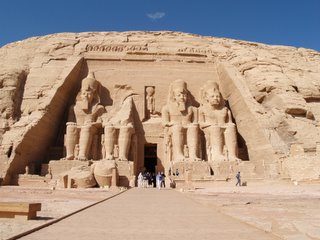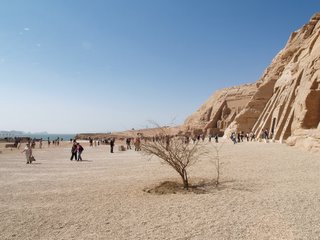
Abu Simbel was built in 1300 BC and is known as The Great Temple of Abu Simbel and even though it was dedicated to Amun of Thebes, Ptah of Memphis and Ra-Harakhty of Heliopolis, it was really to honor Ramses II.
Abu Simbel's Temple Facade was buried for centuries but was found in 1813. The large statue on the left is Ramses II (they call these huge statues Colossi) and he was depicting himself as a god. The broken statue next to Ramses II happened during an earthquake in 27 BC (when they moved it they put the pieces in the same place they were originally found). The smaller statue in the wall, right above the entrance is of Ra-Harakhty, the god for Heliopolis.
Ramses II was interesting in that he lived to be 92 and the one wife he loved more than any other was Nefertari, who died when Ramses II was only in his 40's. The 2nd photo is of her temple (known as the Temple of Hathor, of which he made Queen Nefertari's image as if she was the Goddess Hathor). The Colossi alternate between Ramses II (also depicting himself as a god) and Nefertari as the Goddess Hathor.

The temple was actually relocated because of the High Dam that was built in the 1960's and quickly what became known as Lake Nasser (after the first President of Egypt 1956-1970) was puting the original site in danger of going under water. Lake Nasser is the largest man-made lake at 310 miles long. About 800,000 Nubians who had lived in this region since the Pharoahs' time, moved just ouside the lakes reach and near Aswan. When we flew to Abu Simbel from Aswan, it took about an hour and it was mostly flying over this great lake.

The last photo is a shot of the two temples with Lake Nasser in the center left.

No comments:
Post a Comment